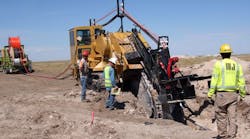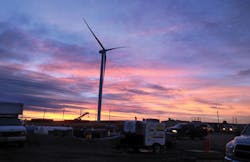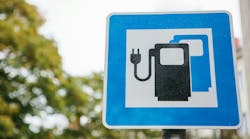The blades nearly stopped turning on new wind energy projects early this year due to a delay in the extension of federal Production Tax Credits (PTCs). Only 1.6MW was commissioned in the first quarter — and none in the second quarter, according to the American Wind Energy Association (AWEA).
Congress finally announced the extension of the PTCs on January 1, but by then, it had already adversely effected this sector. Because wind farms can take 18 to 24 months for commissioning and development, the delay significantly stalled work in the early part of the year.
“The wind turbine building business depends entirely on the federal Production Tax Credits,” says Ken Simonson, chief economist for the Associated General Contractors of America and president of the National Association for Business Economics. “They have expired a number of times, and there have been gusts and lulls in terms of turbine construction. This year, there were no orders on the books.”
When the credit was set to expire at the end of 2012, the industry experienced a surge of activity to finish projects and get new sites underway. This year, Congress attempted to avoid the year-end rush by making a modification to the December 31 extension. (Construction on the wind energy projects must begin by that date to qualify for the credit rather than be placed into service by the deadline.)
Now that the credit looks like it might really go away at the end of this year, the orders are starting back up again, Simonson says. This activity, he predicts, should continue on into 2014.
In fact, the AWEA stated that as of late July, more than 20 RFPs had been issued, 1,300MW was under construction, and more than 3,600MW in power purchase agreements had been secured. Most of these projects are located in North Dakota down through the Midwest and into Texas; however, California, Michigan, and New York are getting their share of the action due to state policies and competitive prices, according to the AWEA. In the long term, uncertainty remains, Simonson says.
“The credits are only for one year, so I don’t think you’ll see any new orders up to October or even earlier unless Congress extends the credits,” Simonson says. “While some projects have been ordered, there has been a gridlock in Congress. I don’t think you’ll see any action until next year.”
Danny Hinds, vice president, renewable energy at M.J. Electric, LLC, a wholly owned subsidiary of Quanta Services, Inc., also expects the future of the PTCs to have a significant impact on the industry.
“Renewable Portfolio Standards continue to drive development whether the PTCs exist or not, but the PTC impact will affect the rate of change,” says Hinds. “As the PTCs go away, the smaller players will struggle or vanish.”
As more states adopt renewable portfolio standards, the market is becoming more saturated. In turn, there are less private equity developers investing in the sites, and more utilities or large construction companies funding and managing the projects. For now, however, the wind energy market offers opportunities to electrical contracting firms with the proper level of expertise and experience. Hinds expects the large-scale wind market to continue with steady or increasing volume for the next five years. At the same time, the industry also presents certain challenges. In many cases, the sites are very far from one another. In addition, when one location is built out, there may be no other projects in that geographical area for many years.
“You can’t just bid on one package and then go back to wiring houses or installing generators,” Simonson says. “You have to develop expertise and have the specialized capital and labor to do multiple projects — and you have to be willing to travel.”
Wind farm development can face a host of other obstacles as well — from environmental and/or community opposition to siting and construction activities. In many cases, electric utilities must also build new transmission lines to carry the power to the area where it will be consumed, and contractors must work with these utilities to interconnect the projects to the grid.
Because the turbines can be more than 400 ft high, companies often need to invest in special erection equipment to install these structures. Increasingly, contractors are also seeing a potential increase in the amount of offshore installations. The construction equipment and expertise required to install offshore wind turbines is very different than on-land structures, Hinds says.
Finding qualified manpower to staff multiple, concurrent wind turbine projects can also be problematic for electrical contracting firms, says Hinds. Prior experience is the key to landing work in this market segment. The Iron Mountain, Mich.-based firm has been involved in a variety of large-scale wind projects as the lead of an engineering, procurement, and construction team or as the electrical construction contractor. On these projects, M.J. Electric is often responsible for installing the electrical connections to the generator, collector systems, interconnection substations, and transmission lines. Some of the contractor’s recent projects include: Echo Wind Farm for DTE in Pigeon, Mich., with 70 turbines; Tuscola Bay for Nextera in Fairgrove, Mich., with 59 turbines; Beebe Wind Farm for Exelon in Breckenridge, Mich., with 34 turbines; Bishop Hill Wind Farm Phase II for MidAmerican Energy in Cambridge, Ill., with 50 turbines; and wind farms for DTE in Bad Axe, Mich., with 69 turbines.
After these towers are operational for a few years, there is a growing opportunity for electrical contracting firms to take on maintenance and repair work, Simonson says.
“This is a niche that is not as well developed yet,” he notes. “Most of the projects are intended to be in place for a long time, and they will need occasional maintenance. That is a specific area that electrical contractors can develop an expertise in.”
Fischbach is a freelance writer based in Overland Park, Kan. She can be reached at [email protected].





